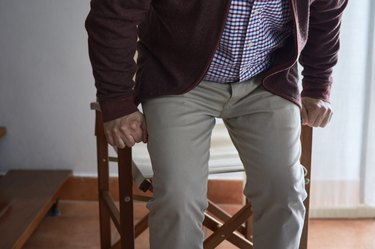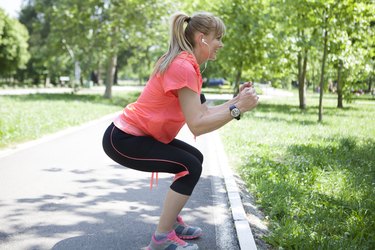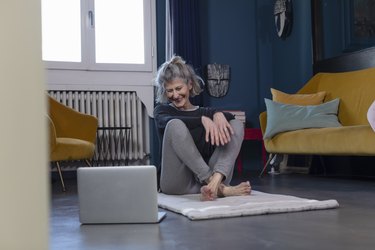
Placing a book on a high shelf, bending over to pick something up, getting up from a chair — there are a few daily motions that can feel a lot more challenging as we age.
When you have trouble getting out of a chair, it's a sign that you may need to give your mobility and strength training some extra attention, Melissa Garcia, DPT, CSCS, a Washington-based physical therapist says. Over the long term, some simple exercises can help improve your balance and stability, reducing your risk of injury and falls.
Video of the Day
For those who need a little extra help getting up from the toilet or couch, quad, glute and hamstring strength is a top priority, she says. To help make your daily movement a little easier, she recommends you do these exercises every other day (or every two days if you notice your muscles are especially sore afterward).
Exercises to Help Getting Up From a Chair
1. Glute Bridge
Glute bridges are a top exercise Garcia recommends for people having trouble getting up from a chair. This move strengthens your glutes and hamstrings (major muscles used when standing up), and your two main hip extensors.
"[Hip extension is the] action that allows our bodies to comfortably stand up straight," she says. And the glute bridge allows you to practice this motion in a lying down position, offering a little. more support and control.
- Lie on your back with your arms at your sides, feet flat on the ground and knees bent.
- On an exhale, squeeze your glutes, press into your heels and drive your hips up toward the sky.
- Raise your hips until you form a diagonal line from knees to hips to chest.
- Pause here for a moment.
- Reverse the motion and return to the starting position.
Tip
For some extra stability, do this move on the floor next to a couch or sturdy chair to help you more easily get down onto and up from the ground.
But if getting down onto the floor feels challenging or uncomfortable, you can do this exercise lying down on a bed or couch.
Alternative: Standing Fire Hydrant
If you struggle with the glute bridge or getting onto the floor, perform the standing fire hydrant instead. Like the glute bridge, this exercise also strengthens the glutes and hip extension muscles used to sit and stand, according to certifed senior fitness trainer Julie Wilcoxson, CPT.
- Stand with your feet together with a mini resistance band looped around your legs just above the knees. Place your hand on the back of a chair for support.
- Bend one knee to raise your foot behind you.
- Keeping your knee bent, press it out to the side until you feel a squeeze in the muscles on the outside of your hip.
- Return to the starting position by lowering your knee to meet the knee of your stationary leg.
- Repeat until you’ve completed all reps on one leg. Switch sides.
- Do 2 to 3 sets of 10 to 12 reps per side.
Tip
To make this exercise easier, omit the resistance band.
2. Straight Leg Raise
Straight leg raises help strengthen your hip flexors (the muscles running across the front of your hips). But these also target your core and help strengthen your quads (the muscles across the front of your legs). Leg raises even build muscle endurance (so you don't get tired as quickly) and control while keeping you in a comfortable, lying-down position.
"Notice that once your quad starts to fatigue, your knee will start to bend," Garcia says. "If this happens, take a break until you feel ready to try another repetition."
- Start by lying down on the ground or on a couch with your knees bent, feet flat on the ground and arms at your sides.
- Straighten your right leg, placing the heel on the floor.
- Rooting your left heel into the ground, slowly raise your right leg a few inches to a foot off the ground, keeping the knee as straight as possible.
- Pause for a moment and gently bring your right leg back to the ground.
Tip
When you do exercises lying on the floor, you want your lower back to be as flat against the ground (or bed) as possible. If this feels uncomfortable, you can place a thin pillow or towel underneath your back for extra support and comfort.
Alternative: Assisted Forward Banded Lunge
Can't get on the floor for the straight-leg raise? Give the assisted forward banded lunge a try. "The forward lunge engages the glutes, hamstrings and quadriceps, which help strengthen the legs," Wilcoxson says. "This will build the strength necessary to go from a seated to a standing position."
- Stand with your feet together and a mini resistance band looped around your ankles. Place your right hand on the back of a chair for support.
- Keeping your right heel on the ground, step your left foot as far forward as you’re able.
- Step your left foot back to meet your right. Repeat until you’ve completed all reps on one leg. Switch sides.
- Do 2 to 3 sets of 10 to 12 reps per side.
Tip
To make this easier, omit the resistance band.
3. Side-Lying Hip Abduction
Your glutes are the biggest muscles in your lower body. But when these muscles are weak, they can cause your back to take over when you're doing day-to-day activities like getting up from a chair or picking something up off the ground.
Garcia likes this exercise because it targets the hard-to-reach muscles in your side glutes. Plus, the side-lying position helps you really isolate the muscles, so you're not using other parts of your lower body to help complete the exercise.
- Lie on your right side with your legs straight and hips stacked. Place your right arm under your head and left palm on the ground for support.
- Gently bend your right knee to a 90 degree angle, keeping your left leg straight and extended.
- Slowly raise your left leg a few inches to a foot off the ground.
- Pause for a moment.
- Lower the left leg back to the ground.
Alternative: Banded Seated Hip Abduction
Don't want to get on the floor? The seated hip abductor is a more accessible exercise for targeting the gluteus medius, "which aids in balance and stability when transitioning from a seated to a standing position," Wilcoxson says.
- Sit in a chair with a mini resistance band looped around your legs just above your knees.
- Scoot forward in the chair until you’re able to place both feet flat on the floor, hip-width apart.
- Sitting tall, push your knees apart until you feel a squeeze in the muscles on the outside of your hip. Make sure the knees are aligned.
- Bring your knees back together with control. Repeat.
- Do 2 to 3 sets of 10 to 12 reps.
4. Supported Mini Squats
"This is essentially the mini version of getting out of a chair," Garcia says. Many people struggle to get up out of a chair because they have trouble keeping their balance. But the mini squat exercise practices that motion, while still offering a little extra help with balance.
- Stand behind a sturdy chair or couch, placing your hands on the back rest for extra support.
- Move your feet to about hip-width distance.
- Gently push your butt back and bend your knees to about a 45-degree angle.
- Reverse the motion and push your hips forward to return to standing.
Tip
Try to keep your weight evenly distributed across your feet, Garcia says. This helps provide extra stability while you're doing this exercise.
Alternative: Wall Sit
The wall sit tends to be equally accessible as the supported mini squat, but Wilcoxson notes that this can be a great move for days when you don't have a chair on-hand for the mini squat.
Plus, having to press your back and shoulder blades against the wall can help you build better posture for transitioning from seated to standing, Wilcoxson says.
- Stand with your back pressed firmly against a wall, feet hip-width apart.
- Keeping your back pressed against the wall, bend at the knees and slide down as far as you’re comfortably able.
- Tighten your abdomen and press your lower back and shoulder blades into the wall. Hold this position for four or five breaths.
- Stand to return to the starting position.
- Do 2 to 3 sets.
- Harvard Health Publishing: “5 Tools to Help You Stand Up on Your Own”
- Harvard Health Publishing: “Two Questions Can Reveal Mobility Problems in Seniors”
- JAMA: “Mobility Limitation in the Older Patient”
- BioMedical Engineering OnLine: “Peak Hip and Knee Joint Moments During a Sit-to-Stand Movement Are Invariant to the Change of Seat Height Within the Range of Low to Normal Seat Height”
- American Council on Exercise: “5 Chair Exercises for Older Adults”
- Centers for Disease Control and Prevention: “Chair Rise Exercise”
- Los Angeles County Government: “Exercise for Older Adults”


